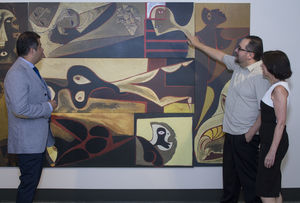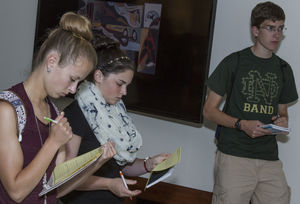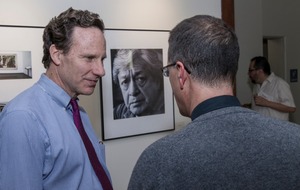
Art in Motion: Guayasamín’s Ecuador Unframed




Art in Motion: Guayasamín’s Ecuador Unframed, was an exhibit whose aim was to heal, unify, and enlighten our community, as Fr. Jenkins challenged us to do in his September 2011 message. The exhibit was housed at the Notre Dame Center for Arts and Culture (NDCAC) on West Washington Street in South Bend in fall 2014.
Enlighten. We designed this exhibit, a collaboration between a faculty research group headed by Carlos Jauregui and a teaching group headed by Tatiana Botero with professors Rivers-Parroquín, Mangione-Lora and Topash-Ríos, to bridge cultural theory, mathematical analysis, media visualization, pedagogy, and computer programming in an innovative installation of the mural Ecuador (1952), a major art work by Oswaldo Guayasamín. Guayasamín was one of the most prominent Latin American artists of the twentieth century. The original mural is currently housed at La Capilla del Hombre in Quito, Ecuador. Due to an historical mistake, however, it was framed and thus immobilized… until this project was undertaken. The South Bend and Notre Dame communities had access to the only archival quality reproduction of the mural. The exhibit included a digital interface which allowed visitors to view 30,720 potential configurations of the piece, and even to create their own mural at The Crossroads Gallery at the Notre Dame Center for Arts and Culture.
Unify. In addition to choosing a site that invited community participation, we invited educators from over three hundred schools, colleges and universities to schedule field trips for students, join us for the events and consider incorporating this unique and powerful exhibit into their courses. Lesson plans by area school teachers from disciplines as diverse as math, art exploration, Spanish, and language arts, as well as additional resources and instructional YouTube videos are available to the public through our website.
Heal. Identity is always in motion, and Guayasamín’s mural evokes this sentiment. Intended to represent the inherent antagonisms and racial multiplicity of the Ecuadorian nation, Guayasamín composed the mural of five movable and interchangeable panels that can be arranged in any order and invite constant rearrangement. We encouraged visitors to explore questions of race, identity and healing in the wake of a turbulent and violent past through the themes suggested by the mural. At the opening, we were joined by distinguished speakers, including the grandson of the artist and Director of the Fundación Guayasamín, Pablo Guayasamín Madriñán, Professor Michael Handlesman, an expert in Afro-Ecuadorian studies from the University of Tennessee in Knoxville, and John Warren, Chair of the Pokagon Band of Potawatomi; at the closing Professor Regina Harrison University of Maryland spoke and members of the Pokagon Band gave a blessing for the journey. At both events, live Ecuadoran music was performed and dignitaries from the Ecuadorian Consulate joined us, as well.
An example of community engagement at work that was done as part of Art in Motion was the project completed by Saint Joseph High School teachers. They used the lesson plans they had created for our resource packet with their Art and Spanish students who studied the social justice issue of the impact of undocumented immigration on families. They then created a powerful experience through the collective display of their work; this was followed by the opportunity to share their mural with Pablo Guayasamín when he visited the school. Each of the three SJHS teachers shared individually that they were inspired by this process and intend to do similar projects each year. These are both excellent examples of engaged scholarship.
The NDCAC saw foot traffic of over 860 gallery visitors while Guayasamín – Art in Motion was threre; an increase of 33% over the previous fall. The combined attendance at the opening and closing receptions was 538, many of whom were students bused from campus.
From the University of Notre Dame, the exhibit and materials traveled to Vanderbilt University, Western Kentucky University, Assumption College, Central Connecticut State University, and Southwestern Oklahoma State University, and the Ecuadorian Embassy in Washington D.C.
Many generous sponsors made this project possible: Fundación Guayasamín, the Kellogg Institute, the Henkels Lecture Fund from the Institute for Scholarship in the Liberal Arts (ISLA), the Notre Dame Center for Arts and Culture, the Center for Social Concerns, the College of Arts and Letters, the Morris Inn, the Department of Romance Languages, the Pokagon Band of Pottawatomi Indians and the Institute for Latino Studies.